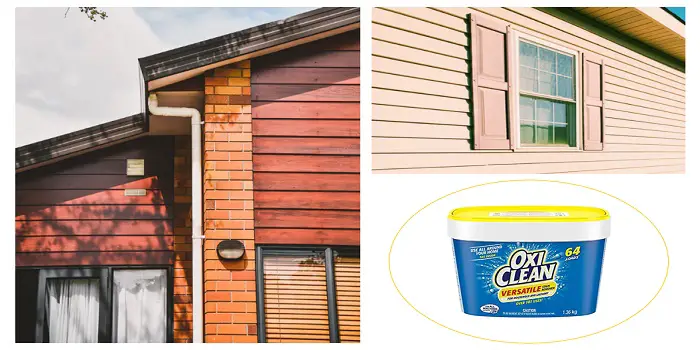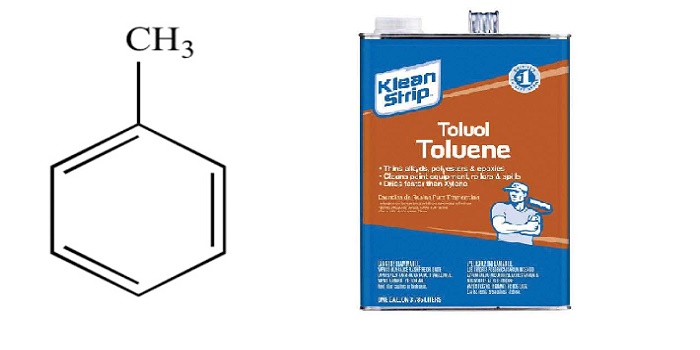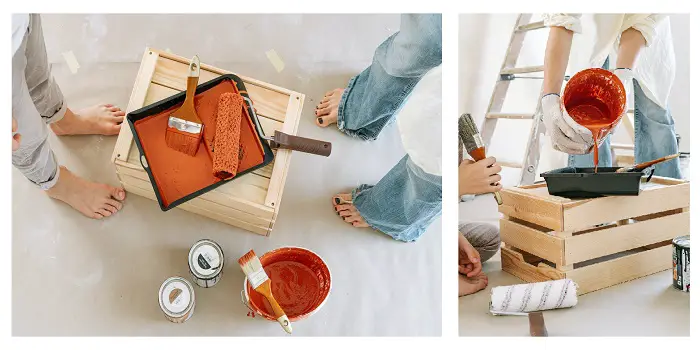
When it comes to painting, everyone wants that smooth, flawless finish. To avoid the dreaded brush stroke jungle and patchy nightmares, one of the best-kept secrets is thinning your latex paint to just the right consistency.
Think of it like making pancake batter: too thick, and it’s a clumpy mess; too thin, and it runs off the griddle (or wall, in this case). The perfect mix allows the paint to flow like a dream, smoothing out those pesky brush marks and giving your surface a fresh, magazine-worthy glow-up.
Latex paint straight from the can is often thicker than your grandma’s gravy, and trying to spray it as-is is a one-way ticket to Clog City. A little thinning helps the paint glide through the sprayer, producing a fine mist rather than a Jackson Pollock explosion. Plus, you’ll save time, your sanity, and a whole lot of paint from being blasted into oblivion.
And let’s not forget the struggles of using thick paint with a brush or roller—because nothing screams “DIY disaster” like streaks and roller lines that refuse to blend in. Thick paint tends to stay where you plop it, leading to that “I tried my best” vibe instead of a seamless look.
But thin it out just enough, and suddenly you’re in control, spreading paint like a pro and creating a finish that says, “Yeah, I totally meant to do that.”
What's Here in the Article:
Thinning Latex Paint with Paint Thinner
Since oil and water do not mix and cannot work together, you should not use solvent-based products like paint thinner, mineral spirits, or turpentine for thinning latex paints.
Paint thinner, when poured into a latex paint bucket will most likely cause the separation of paint pigments and latex polymers that make up the paint. And the end product you get by mixing them will no longer be “paint” but simply trash that is good for nothing.
In other words, since water-based latex paints are incompatible with oils and solvents, you will be left with a crappy mess if you try to mix them with paint thinners or mineral spirits.
As a general guideline, always check the product and the guidelines printed on a paint can label before mixing and thinning them.
If it says “latex,” you should always use clean and fresh water from the faucet to thin the paint down. On the other hand, if it’s an oil-based enamel paint, you will require a solvent-based paint thinner. Do not ever mix water into oil-based paints.
Can Alcohol Be Used to Thin Latex Paint?
While it is technically possible to use alcohol—such as rubbing alcohol (isopropyl alcohol)—to thin latex paint, it is generally not advisable for most painting projects.
One of the major concerns with using alcohol as a thinner is that it can cause pigment separation. While alcohol acts as a solvent latex paint or acrylic is a water-based formula that relies on a delicate balance between the binder, pigment, and water.
Alcohol can disrupt this balance, especially when used in high concentrations. It may cause the pigments to separate from the binder, leading to poor color consistency and reduced adhesion. This not only affects the final appearance but may also weaken the durability of the painted surface over time.
When used in excessive amounts, alcohol can also cause the latex paint to dry too quickly, leading to uneven application, streaks, or clumps. This rapid drying can make it difficult to achieve a smooth finish, especially when working on large surfaces or in warm environments.
However, if you’re still interested in experimenting with alcohol, it should only be done in very small test batches. Begin with minimal quantities and add incrementally, carefully observing how the paint reacts before proceeding further.
Even then, it’s best used only in niche scenarios or for small touch-up jobs where precise finish quality isn’t as critical. For most projects, sticking with water or a dedicated thinner ensures the best results without compromising the paint’s properties.
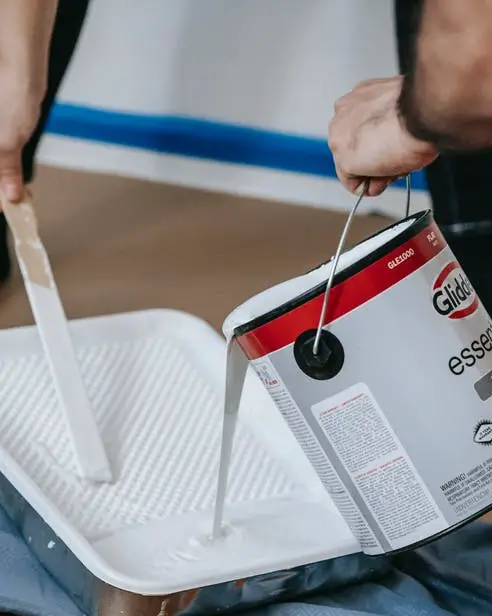
So, How to Thin Latex Paints for Brushing or Rolling?
If you are using a paintbrush or a roller, the best way to thin latex paint and primer is by pouring them into a bucket and adding water.
Water is compatible with the paint’s composition and helps maintain its integrity while allowing for smoother application and easier cleanup.
How much water you will need to thin latex paint will generally depend on the type and brand of paint you will be using. But in most cases, you should be fine with adding about 1½ cup of water for every gallon of latex paint.
It’s good NOT to add this much water at once. But start with ½ cup of water and then add gradually as you need.
- Mix it thoroughly using a thin wooden stick or a paint stirrer
- Add some more water (if required) while you are still stirring the paint with a stirrer
- Mix it for several minutes until you get the right consistency
To check the paint for its viscosity, you can finally run the thinned-down paint through a funnel.
If it flows freely, it’s clear that the paint you now have is thinned enough and can be applied easily using a paintbrush or a roller.
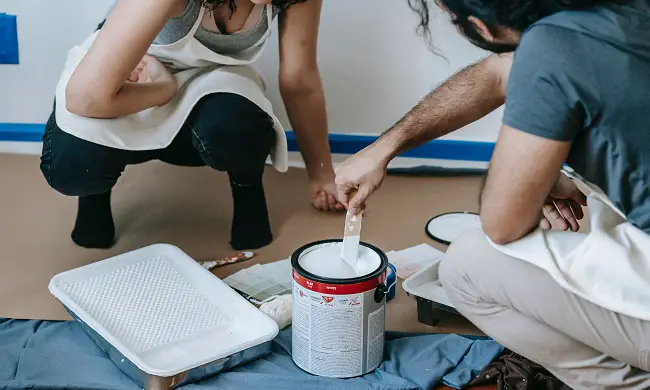
Tips for Thinning Latex Paint for Your Wagner Spray Gun
Wagner spray paint guns are most popular when it comes to spraying latex paint.
But before you can spray (your walls, ceilings, or exterior bricks) with this machine, you will need to thin the latex paint with water to the extent that it is neither too thin nor too thick.
If you make it too thin, the paint will be watery. And you will need to put several layers before you can get a nice look.
If the paint remains too thick, the sprayer will have a hard time spraying the paint, and you will be wasting your time and efforts trying to fix the problem.
Basically, you will need to get the right consistency that does not hamper the machine’s functionality and can be sprayed easily without clogging the nozzle.
Wagner sprayers suggest the following steps for latex paint thinning…
- In a 5-gallon clean paint-bucket pour 1/2 gallon of water
- Next, pour 1 gallon of latex paint into a bucket with water
- Place the lid of the bucket and shake the mixture well 4-5 times
- Open the lid and check the consistency of mixed paint using a funnel with a small spout
- If the paint does not flow freely and is not thinned well (according to the paint sprayer specifications), add about half a cup of water and shake the mixture again
While thinning the latex or acrylics, also determine where you will be applying the paint (like interior or exterior), on what kind of surface (whether porous or non-porous), and how many layers of paints you will be putting.
All of these factors will also play an important role in deciding how thin you want your paint to be.
Few Tips and Precautions:
Always spray the paint on a small area (like a siding or a piece of plywood) to test and determine the consistency of the paint.
If you are using old used paint, stir it well and strain it before you spray it using your sprayer machine. This will remove any dirt or debris that may have accumulated.
If you think thinning latex paint will change the color, you are wrong.
Thinning the paint will not change its color. But to achieve the right color, you will need to apply more coats.
Temperature and humidity will also affect the thickness of the paint.
If it’s cool weather you are working in, you will need to thin your paint a bit extra compared to hot weather.
Related Questions
Can You Over-Thin Latex Paint?
Latex paint when over-thinned can cause several issues. You’ll notice the paint may not stick properly and could start peeling, the color may appear lighter due to a diluted pigment ratio, and the paint might drip excessively because it becomes too runny. Additionally, it may dry too quickly without hardening correctly, leading to poor adhesion.
To fix over-thinned latex paint, the solution is simple: just add more paint to restore the proper balance and consistency.
Can You Thin Latex Paint with Floetrol?
Thinning latex paint with Floetrol isn’t your solution because it’s a paint conditioner and not a paint thinner.
Floetrol is a product that can help make your latex paints work like oil paints. This means if you need to perform a paint job in conditions that are not ideal (like at high temperatures or low humidity), you can mix a Floetrol conditioning agent to the paint.
This will prevent the paint from drying too fast and will make spraying much easier through your spray gun.
There are, however few drawbacks you will need to keep in mind when using Floetrol. These include:
- It can make your paint go runny
- It’s not recommended for oil-based paints
- It can reduce the sheen of high gloss paints
- It increases the drying time of the paint, so you need to plan accordingly
Can You Use Paint Thinner to Clean Latex Paint Brushes?
Latex paint, if dried on your paintbrush or a sprayer, can easily be cleaned in a sink using warm water. Stubborn paint will, however, require some elbow and grease.
If you find the paint hard to remove, you can also use a small amount of mineral spirits or lacquer thinner to soften the paint which will make it easier for you to remove the dried paint from the brushes.
The process should be followed by rinsing with warm soapy water and finally with fresh, clear water. After the cleanup, you can further soften your hardened paint brushes using products like baby oil if you want.
Final Thoughts
Paint thinners and mineral spirits are petroleum-based products. These are not meant to work on water-based primers, latex paints, and acrylics. You should only use them for thinning oil-based paints and removing oil-based paints from paintbrushes, rollers, or other equipment while the paint is still wet.
For thinning latex paints regular tap water in a proper ratio is only a recommended option. If you need to adjust the consistency for a particular tool, such as an airbrush or HVLP spray gun, specialized latex paint thinners are available on the market. These are designed to maintain the paint’s quality while achieving the desired flow and finish.
Share the post "Can You Thin Latex Paint with Paint Thinner?"

Douglas Becker (aka Painter Doug) has over twenty years of experience as a painter in Adkins, Texas. At present, he resides in Florida with his family.
From painting multi-storeyed houses, condos, and apartments to large commercial buildings and small offices, he had served various customers in areas not only in Adkins but also in Southwest Florida, Sarasota, Naples, and many more. To know more about him check here.



